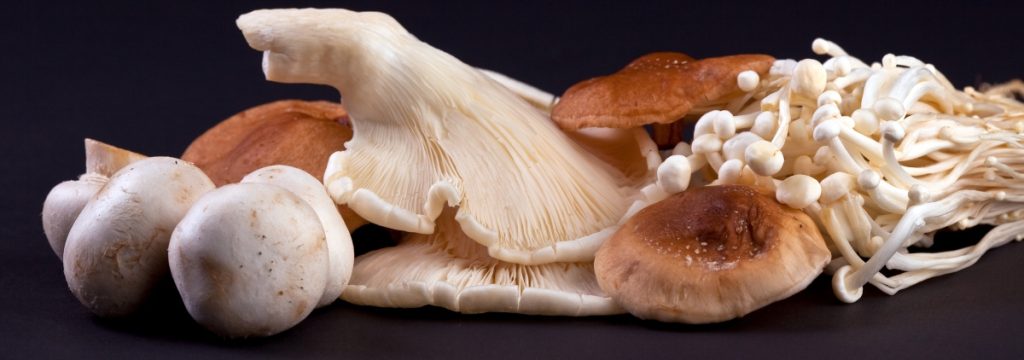Mushrooms are growing in popularity, and more and more varieties are now available at grocery stores and farmers markets.
When faced with so many options, you may be wondering what these new and exotic mushrooms taste like and how to use them.
Incorporating mushrooms into your daily meals provides rich flavors and numerous health benefits, but it’s not always easy to know where to start.
In this article, we explore the tastes of 16 popular mushrooms and the best ways to prepare them.
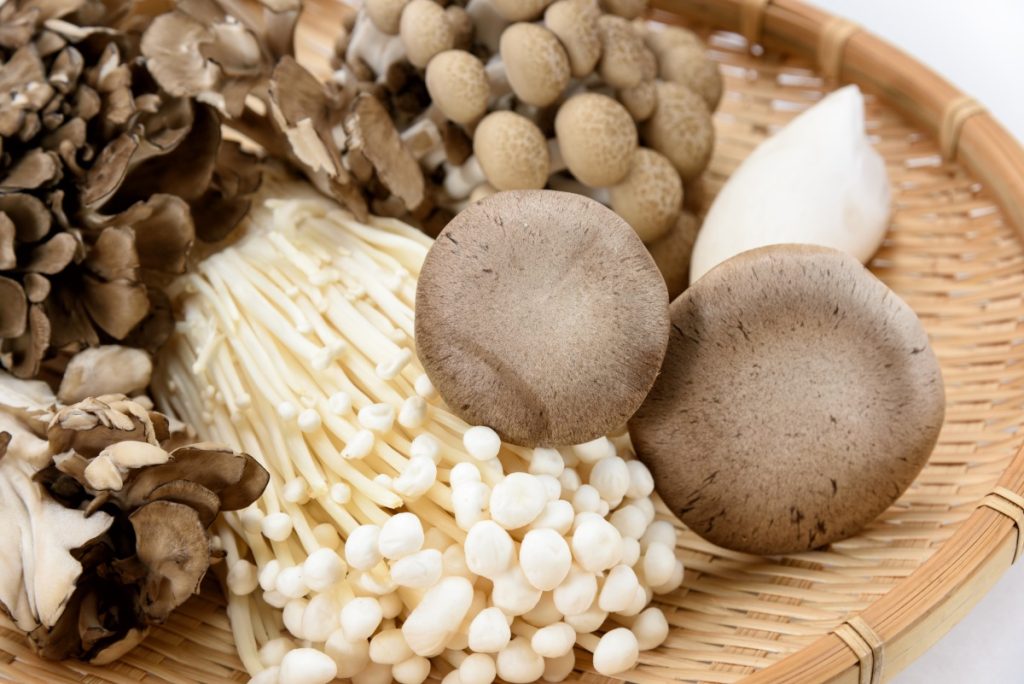
What Does Mushroom Taste Like?
Edible mushrooms have an earthy, slightly woodsy, meaty flavor and are one of the foods that contain umami, the fifth primary taste.
Chefs describe umami as a savory, brothy taste that spreads across the tongue and lingers in your mouth. Being a primary taste, it’s unique, and you cannot create it by combining other tastes.
Mushrooms have delicious flavors that vary from rich and decadent to subtle, delicate and fresh depending on the type of mushroom.
Because of their meaty, umami taste, vegetarians and vegans often use mushrooms as a meat substitute in their dishes.
The Benefits of Umami Foods
Foods that contain the fifth primary taste have lots of benefits, including:
- Enhanced flavors: The more umami a food has, the more flavorful it will be.
- Enhanced satisfaction: Umami makes your mouth water, creates appetite appeal and makes you feel satiated.
- Reduced salt: Using umami foods in a dish allows up to 50 percent salt reduction without compromising flavor.
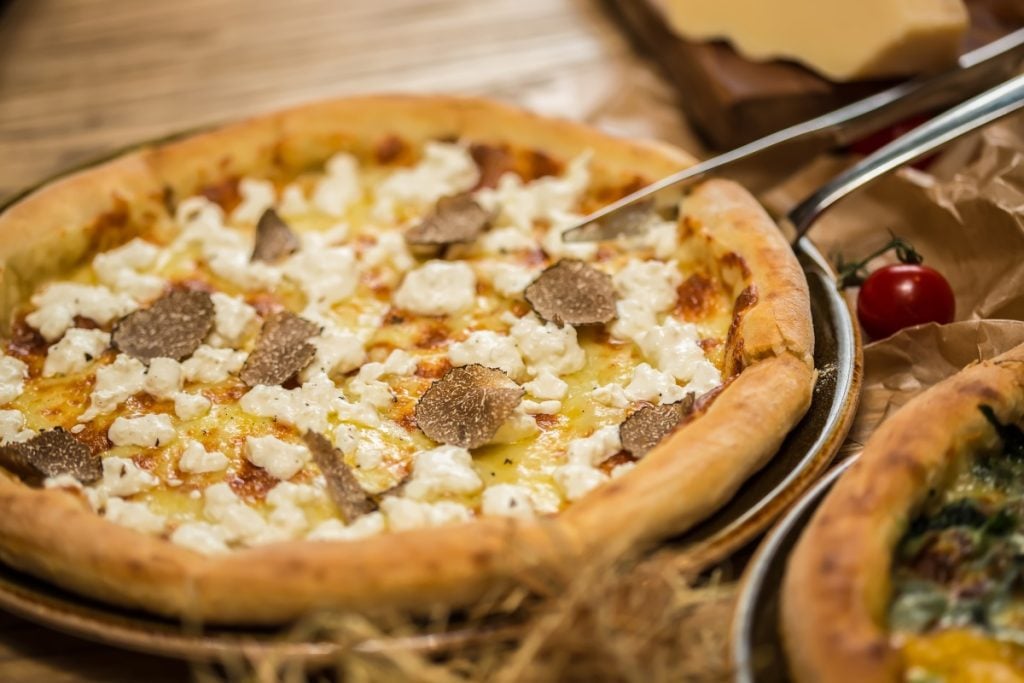
What Mushroom Has The Most Flavor?
All mushrooms have delicious umami flavors, and the darker the mushroom, the higher the concentration of umami flavor.
Some mushrooms known for their rich flavors are chicken of the woods, truffles, morels, porcini, shiitake and portobello mushrooms.
Many of these delicious gourmet mushrooms are also some of the most expensive mushrooms in the world, as they’re not easy to cultivate.
Drying mushrooms intensifies their flavors, and dried mushrooms tend to have more umami than fresh ones.
Examples of mushrooms that are commonly dried for preservation and to enhance their flavors are morel, porcini and shiitake mushrooms.
Cooked mushrooms are also more umami-rich. Adding fresh, dried or powdered mushrooms to cooked dishes will give them a flavor and nutrient boost.

16 Popular Mushrooms’ Tastes and Uses
Mushrooms are extremely versatile and add interesting depth and flavor to almost any dish.
Here’s how 16 popular mushrooms taste and how to use them:
1. Button Mushroom Taste

White or button mushrooms are the most commonly used mushrooms worldwide and have a mild, earthy flavor, sometimes described as slightly nutty.
When raw, their flavor is subtle, almost bland, but it deepens and intensifies when they’re cooked, making them ideal for grilling and sauteing.
Button mushrooms are very versatile, and you can use them in most dishes, including salads. They’re also commonly used on pizza and in pasta sauces.
Because they’re mild and firm, button mushrooms are a good choice for babies.
Feeding themselves with diced, sauteed mushrooms improves babies’ hand-eye coordination and pincer grasp while providing numerous beneficial nutrients.
2. Cremini Mushroom Taste
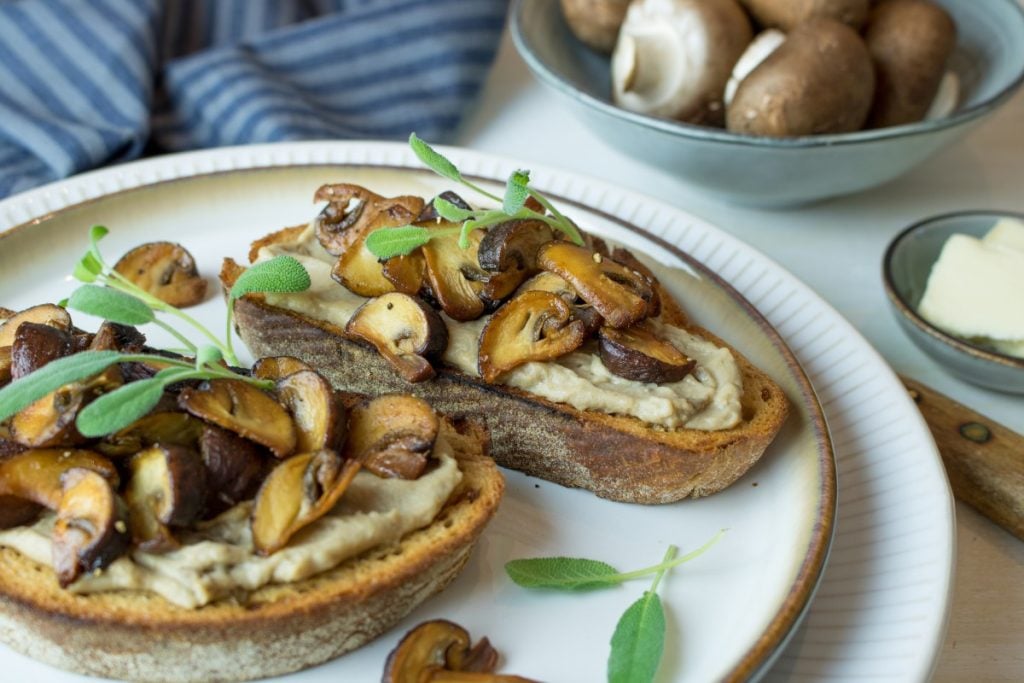
Cremini mushrooms are the same species as button mushrooms but picked later in their development.
Also commonly found in stores, cremini, while still mild, have a slightly bolder, earthier taste than button mushrooms.
Cremini makes a tasty addition to any dish and is good eaten raw, sauteed or roasted. Their texture is similar to a button mushroom, and they brown nicely when sauteed in butter.
You can also enjoy them on their own. A favorite recipe is cremini lightly sauteed in butter with garlic, served on toast.
Some recipes only use cremini caps, but you can also eat the stems. Diced and sauteed stems are delicious in soups and sauces and make a tasty filling for pancakes and omelets.
3. Portobello Mushroom Taste
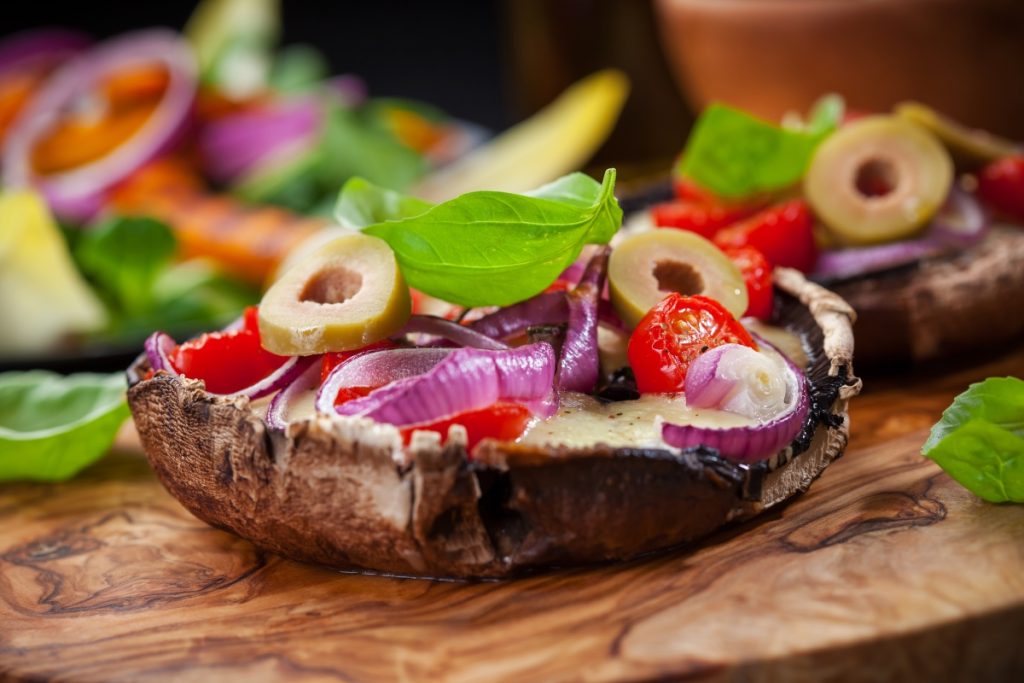
Portobello mushrooms are mature cremini mushrooms. Their large size, earthy, meaty taste, and dense, steak-like texture make them a popular meat substitute.
Portobellos have a richer, more intense flavor than creminis and are ultra-versatile.
Here are some popular ways to use portobellos:
- Whole portobello mushroom caps: When grilled, these are wonderful as burgers or steaks, and the options for stuffed portobello caps are endless.
- Sliced portobellos: Perfect for sauteing, sliced portobellos make perfect finger food for babies and are delicious served with pasta, stir fry, on pizza, to make ragout or alone as a side dish.
- Diced portobellos: These add amazing flavor to soups, sauces and casseroles, and you can use them as a stuffing in burritos, enchiladas, omelets, etc.
4. Oyster Mushroom Taste
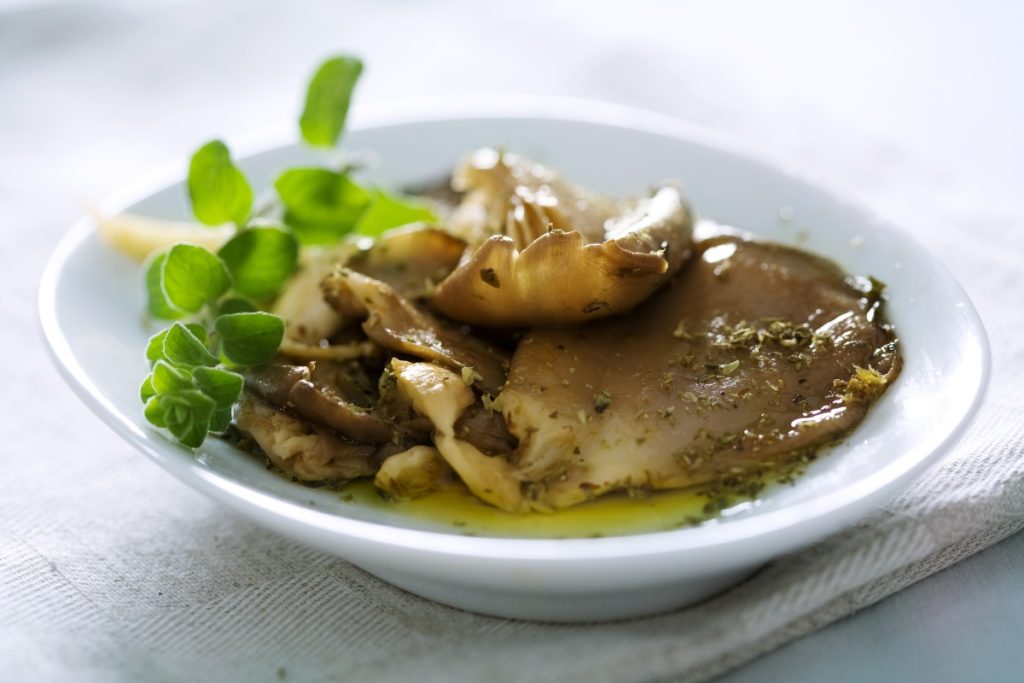
Oyster mushrooms have a light, mild flavor with slightly earthy notes. Some people also describe them as having a hint of seafood or a subtle anise flavor.
But, these flavors are almost indiscernible when incorporated into dishes.
Oyster mushrooms make a great transition mushroom from button, cremini, and portobello to more adventurous types of mushrooms.
Different colored oyster mushrooms are all mild tasting but have slightly different tastes.
Yellow oysters have mild citrus, cinnamon-like flavor, pink oysters taste a little like bacon or ham, blue oysters have a creamy seafood-like taste and phoenix oysters have subtle anise undertones.
Oyster mushrooms pair well with seafood, fish, poultry, and red meat and are delicious sauteed or roasted whole.
Their oyster-like texture stays firm when cooked, allowing you to use them as a meat substitute in dishes.
A favorite use for oyster mushrooms is roasting or sauteing them, whole or sliced, in olive oil with garlic and fresh herbs.
5. King Oyster Mushroom Taste

King oyster mushrooms have a mild, earthy oyster-like flavor with hints of licorice and strong umami tastes. They’re more savory and aromatic than some of the other oyster mushrooms.
Largest of the oyster mushrooms, they’re known for their thick edible stems that, unlike other mushrooms, aren’t tough and woody.
People often describe their dense, chewy texture as similar to scallops or squid.
Mushrooms absorb flavors from other ingredients. The mild taste of king oysters makes them great at taking on stronger flavors such as garlic or soy sauce.
Japanese cooks enjoy cooking with king oyster mushrooms and serve them fried in crispy tempura batter or skewer whole mushrooms and serve them grilled and glazed.
A popular way of serving king oyster stems is thickly sliced into ‘scallops’ and pan-fried, but you can also serve them sauteed, roasted or grilled.
6. Shiitake Mushroom Taste
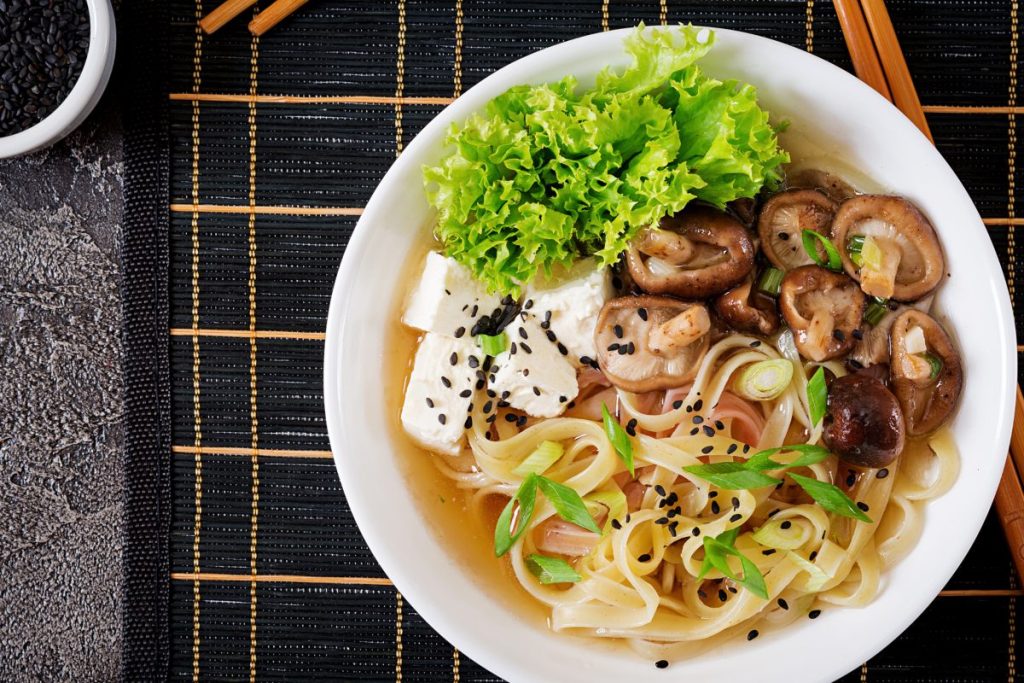
Shiitake mushrooms have a deeper, richer, more satisfying flavor and aroma than many other mushroom varieties.
People describe the taste as woodsy, earthy, buttery, meaty, slightly smoky or filled with umami. Dried shiitakes have even more intense flavors than their fresh counterparts.
Like portobellos, shiitakes make a great meat substitute. People use them to make burgers and replace the ground beef in lasagna or spaghetti bolognese.
You can grill, roast or saute shiitakes, and they’re delicious in stir-fries and soups.
Shiitakes not only provide rich umami flavors, but they also contain nearly all the same amino acids as meat making them one the healthiest mushrooms for a meat-free diet.
7. Porcini Mushroom Taste
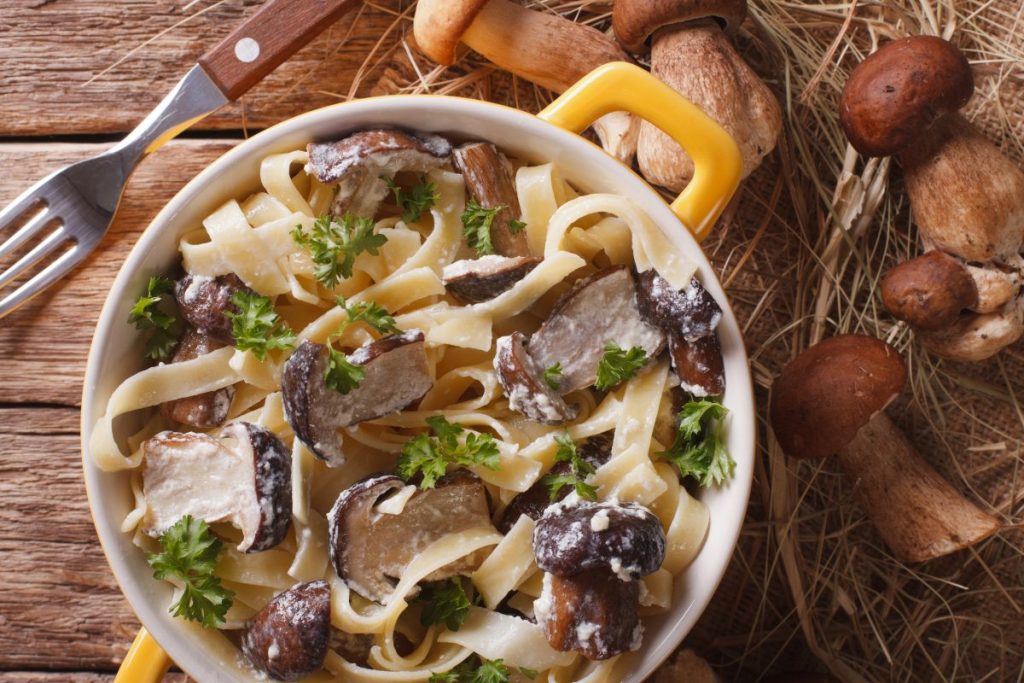
Porcini mushrooms have a distinct taste with slightly creamy, earthy, nutty flavors and a meaty texture.
They’re some of the most sought-after wild mushrooms worldwide and have stronger, wilder flavors than cultivated mushrooms like portobellos.
Their texture is firm and meaty, and they add rich nutty flavors to any dish and play an important role in Italian cuisine.
Dried porcini are less expensive and, when reconstituted, add robust flavors to soups, stews, sauces and stuffing.
A famous Italian way to prepare porcinis is to stew or grill them with thyme or nipitella.
But you can use these versatile gourmet mushrooms in several ways, including:
- In sauce, soups or stews
- Sauteed with or without a coating as an appetizer
- As a topping for steak, chicken, fish or pizza
- In pasta recipes, especially risotto
- Minced and cooked to a paste and served with bruschetta
8. Chanterelle Mushroom Taste
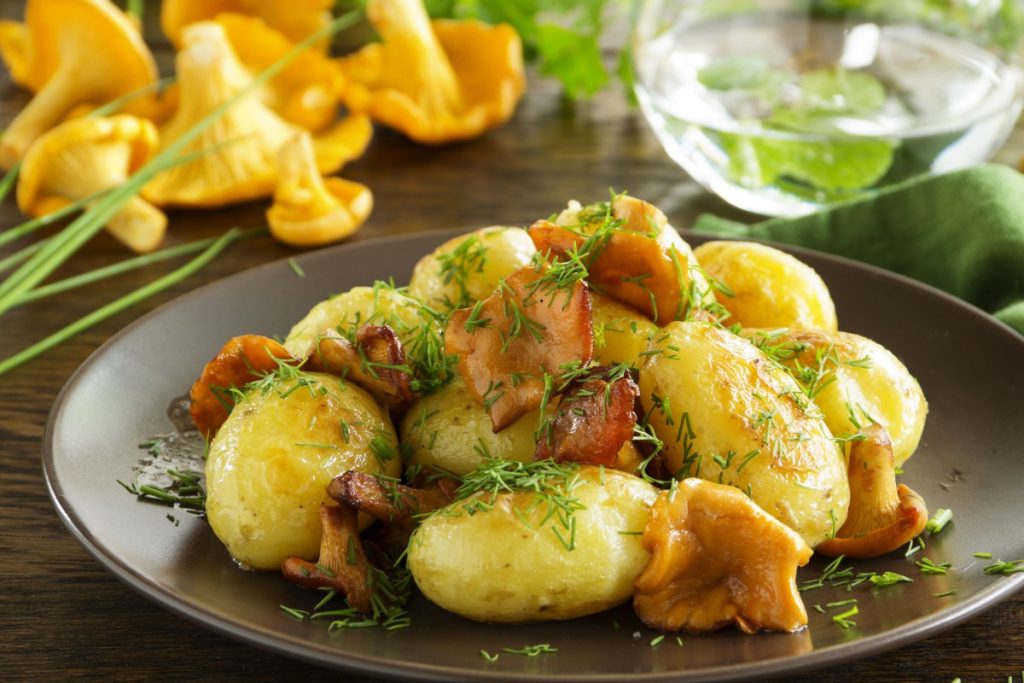
Like many other wild mushrooms, chanterelles have stronger flavors than cultivated mushrooms.
When first picked, chanterelles have a fruity apricot or peach-like aroma, but this is not how they taste.
Chanterelle mushrooms have an earthy, woodsy flavor and a mild peppery taste that goes well with eggs and herbs like chives and tarragon.
Chanterelles are excellent when sauteed or roasted and are often used to add rich flavor to stir-fries and pasta dishes.
9. Morel Mushroom Taste

When it comes to the question, “What does a morel mushroom taste like?” It’s hard to put their taste into words, as morels are unique and have distinct flavors.
People generally describe their deep elegant flavors as nutty, earthy and woodsy. But, depending on how you cook them, they can also be smoky or musky tasting.
Morels taste like they smell. When selecting fresh morels, choose firm fleshy morels with distinct earthy scents.
Prized by chefs, their intense flavors are not overpowering but are distinct, and you can always tell when dishes contain morels.
Morels have a lovely meaty texture but are tender at the same time and are best when cooked simply to showcase their unique flavor.
Fresh morels are tasty when lightly sauteed with a white wine and cream sauce using fresh herbs.
Rehydrated dried morels are less expensive than fresh morels and are available year-round. They’re particularly delicious in broths and sauces.
10. Enoki Mushroom Taste
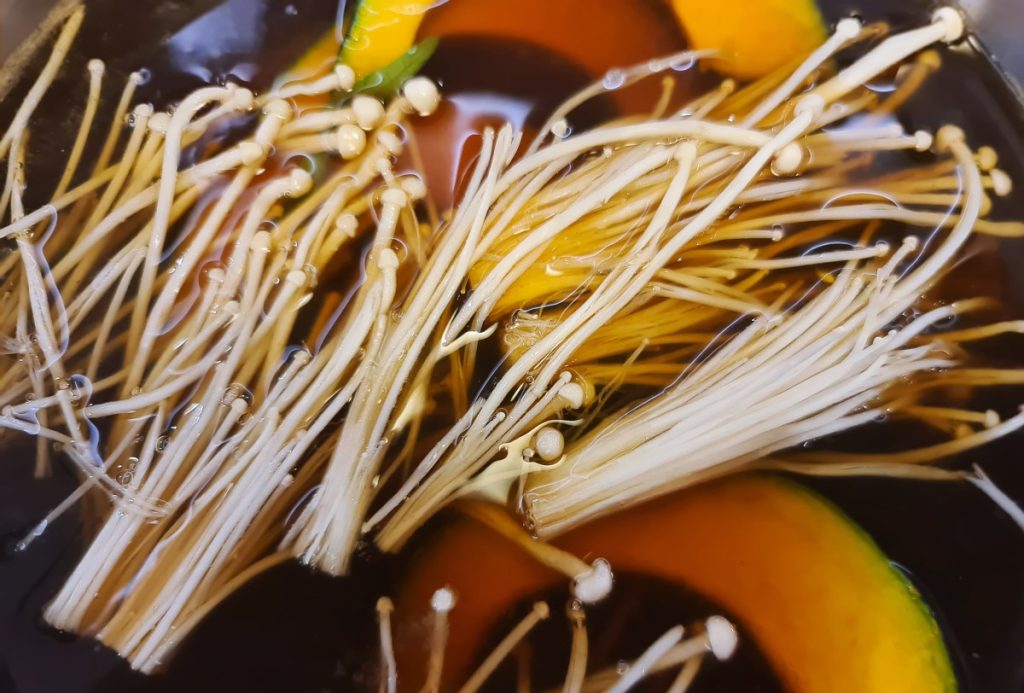
Enoki mushrooms grow in clusters and look rather exotic, and many people in western cultures wonder, “What does enoki mushroom taste like?”
Enoki mushrooms have a very mild, delicate, savory flavor and a firm, slightly crisp texture.
These long-stemmed, small-capped white mushrooms are versatile and commonly used in Asian cuisine.
Served raw, they add a crispy crunch to salads and sandwiches. They’re also delicious cooked in soups, stir-fries, risottos and ramen noodle dishes.
11. Lion’s Mane Mushroom Taste
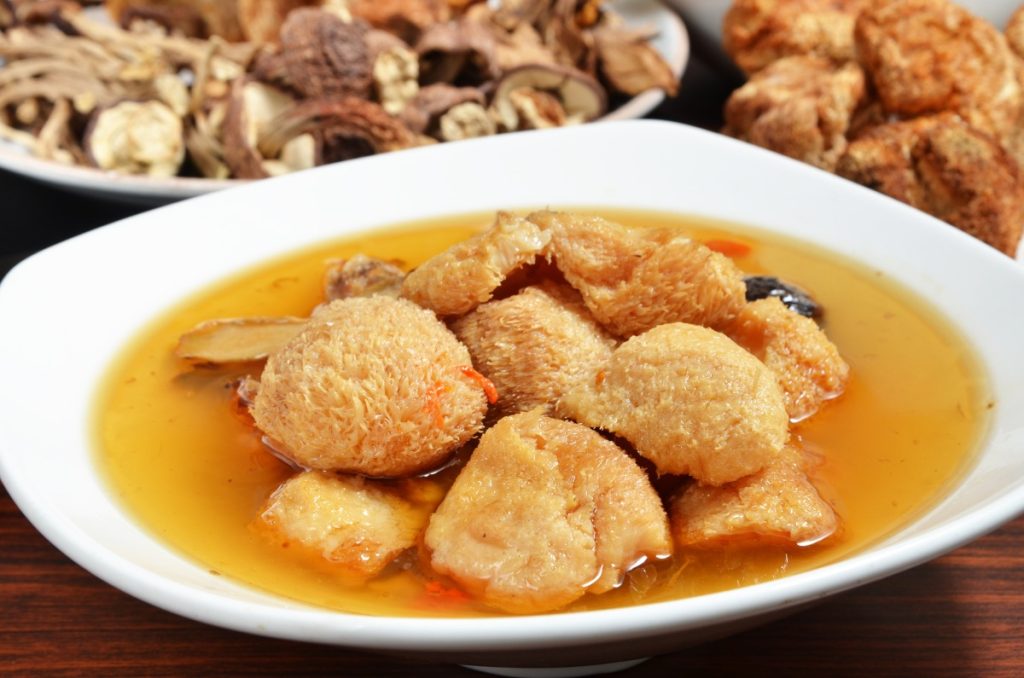
Lion’s mane is one of the more unusual-looking mushrooms, and many people who are unsure about trying them wonder, “What does lion’s mane mushroom taste like?”
Lion’s mane mushroom has a slightly sweet yet savory flavor and a chewy, meaty texture.
Many people describe cooked lion’s mane as having a flavor and texture similar to crab or lobster meat.
To fully enjoy their unique taste, it’s best to cook them as simply as possible because, like other mushrooms, they’ll take on the flavor of any sauces they’re cooked in.
Lion’s mane has a thick stringy texture and is meatier than most mushrooms, making them perfect for sauteing, roasting, deep frying or adding to stews and sauces.
12. Maitake (Hen of The Woods) Taste
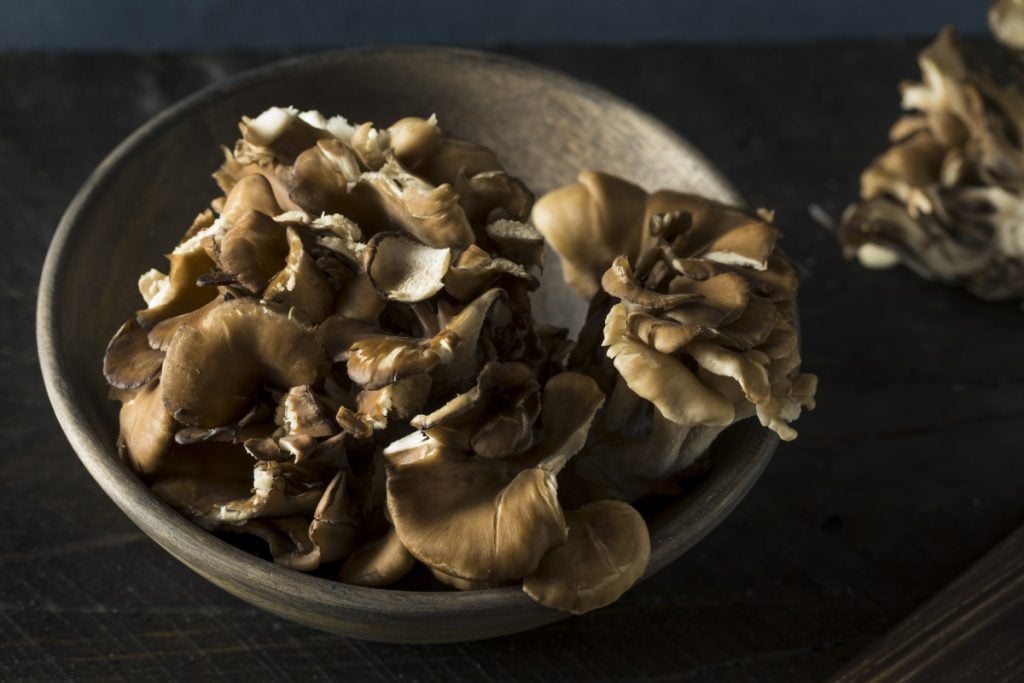
Maitake mushrooms are sought-after for their deep earthy taste, unique texture and sheer versatility.
Although their earthy flavors are similar to other types of mushroom, maitake is more delicate than shiitake, more savory than porcini and has a mildly spicy, peppery flavor.
Their delicate, feathery texture is unique and enjoyed by most people, even those who don’t usually like the texture of mushrooms.
Although most cooks feel maitake is best when sauteed, they’re very versatile, and there are many ways to cook them.
You can roast or deep fry maitake, add them to pasta, risotto or eggs, and even dry slices to eat like potato chips.
Some people have an allergic reaction to maitake, so it’s advisable to try a small portion first and wait for an hour or more to see if you have any reaction before consuming more.
13. Giant Puffball Taste
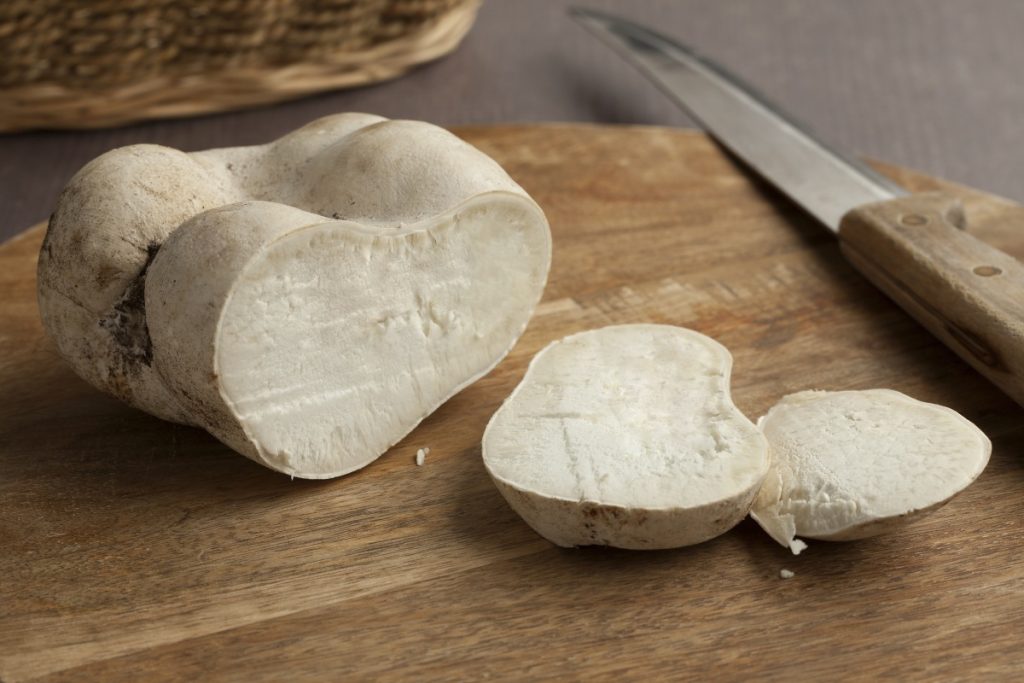
Some people describe a giant puffball’s taste as mild, earthy and nutty.
Others feel it does not have a distinct flavor but soaks up the flavors of spices, herbs or sauces it’s cooked in.
Puffball mushrooms have a delicate texture, and people often use them as a substitute for tofu or eggplant in recipes.
The most popular way to prepare them is to coat sliced puffballs with batter or breadcrumbs and fry them in oil. Doing this helps to prevent them from getting soft and soggy when cooked.
Here are some other ways to enjoy them:
- Sauteed with vegetables
- Broiled alone or with a marinade
- Diced and stir-fried in place of tofu
- As an eggplant replacement in any recipe
14. Hedgehog Mushroom Taste
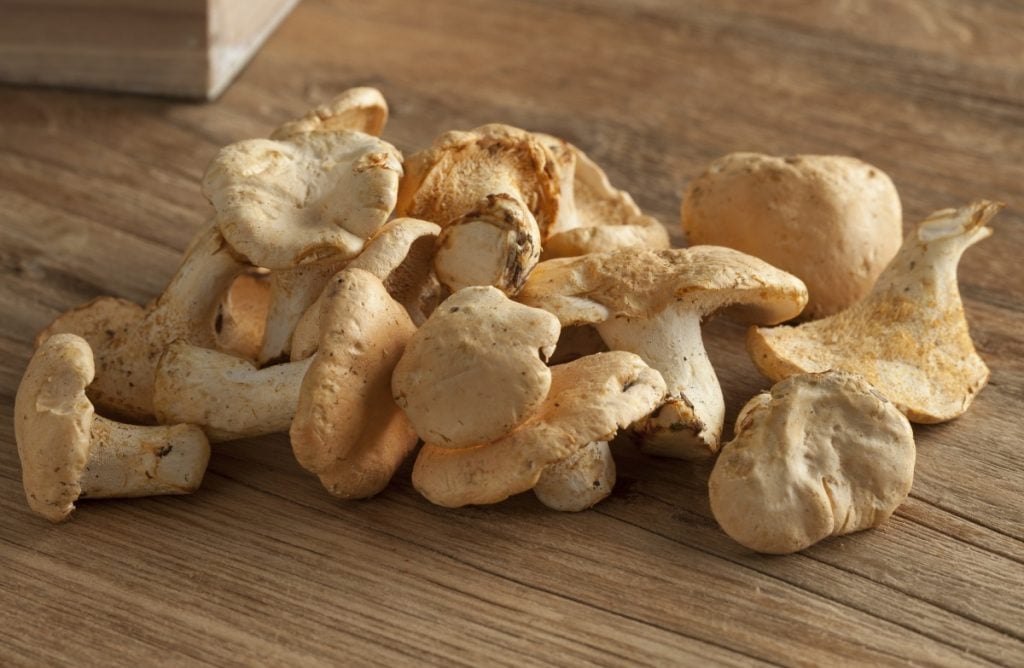
Hedgehog mushrooms have a somewhat sweet, earthy, nutty taste with a peppery aftertaste. Similar to golden chanterelles but with a more traditional mushroom flavor.
The difference is subtle, and you can successfully substitute hedgehog mushrooms for chanterelles in most recipes.
Hedgehog mushrooms have firm flesh and a crunchy texture that’s slightly chewy when cooked and pair wonderfully with cream.
A favorite way to cook hedgehogs, like most mushrooms, is to quickly saute them in oil or butter as it lets the flavor of the mushrooms shine.
Sauteed hedgehog mushrooms are tasty served on their own, but also lovely with pasta, on pizzas, or piled on crostini with a layer of ricotta cheese.
15. Chicken of The Woods Taste
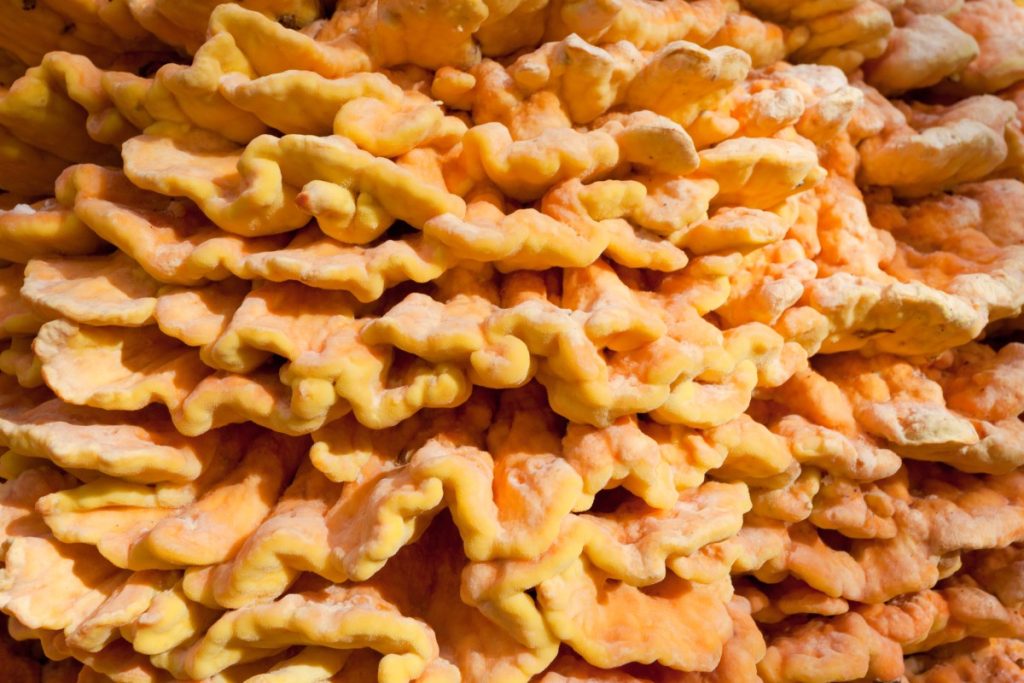
People named this mushroom chicken of the woods because many think it tastes like chicken.
When cooked, this bright orange bracket fungus is succulent, juicy and meaty with a mild flavor that reminds people of chicken.
High in protein, their dense sinewy texture is like tender chicken meat, making them an ideal chicken substitute for vegans and vegetarians.
In fact, you can cook chicken of the woods the same way you would prepare chicken meat.
Chicken of the woods is delicious when cut into pieces or strips and sautéed with wine, butter and herbs. You can also bake or deep fry these mushrooms and serve them with dipping sauces.
Try adding sliced chicken of the woods to risottos, casseroles, curries, egg dishes, rice dishes and soups.
16. Matsutake Mushroom Taste
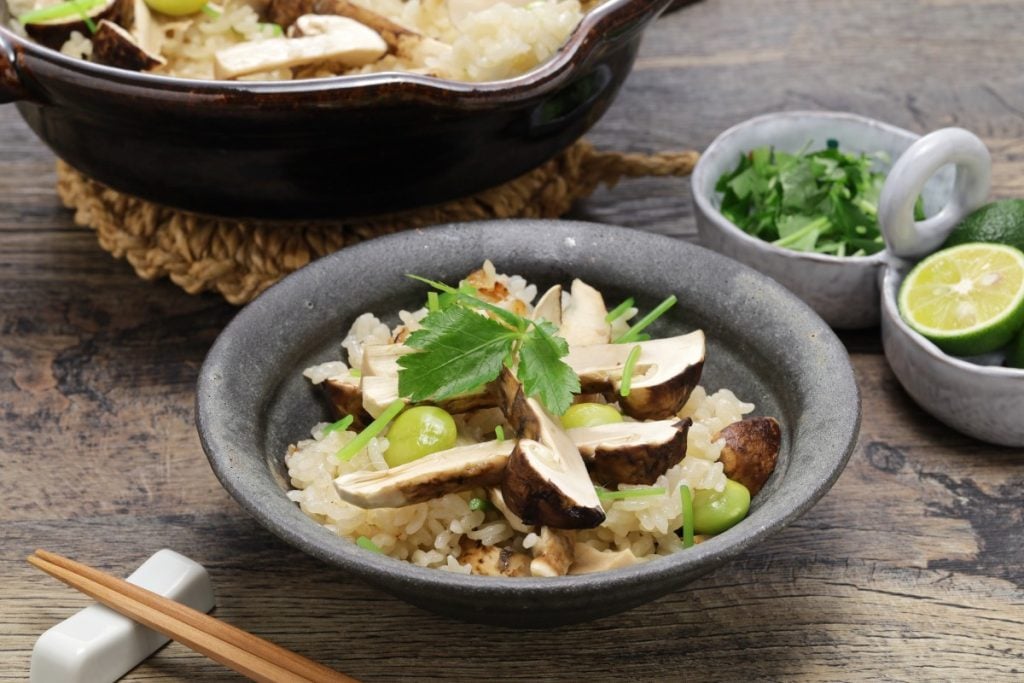
Matsutake mushrooms, also called pine mushrooms, aren’t very well known in the west but are popular in Chinese, Korean, and Japanese cuisine.
Unlike other mushrooms, chefs use matsutake mushrooms for their taste and distinctive spicy aroma with hints of cinnamon and cypress.
Their unique flavor is clean and spicy, and their texture is firm, meaty and satisfying.
As with most mushrooms, chefs seem to agree that simple preparations are the best way to showcase matsutakes’ unique taste, texture and aroma.
Although they work well in different dishes, it’s advisable to start with Japanese recipes and then branch out.
Try using smaller amounts initially, as matsutake’s fragrance may be overwhelming.
Which Mushrooms Do People Use as Meat Replacements?
Several mushrooms make excellent meat replacements, especially larger mushrooms with firm, meaty textures.
Portobellos are readily available and less expensive than many other mushrooms, making them the most commonly used substitute for steak or beef.
Other common mushrooms that make excellent meat substitutes are cremini, shiitake and oyster mushrooms.
And, of course, chicken of the woods is a fantastic substitute for chicken (but so is maitake).
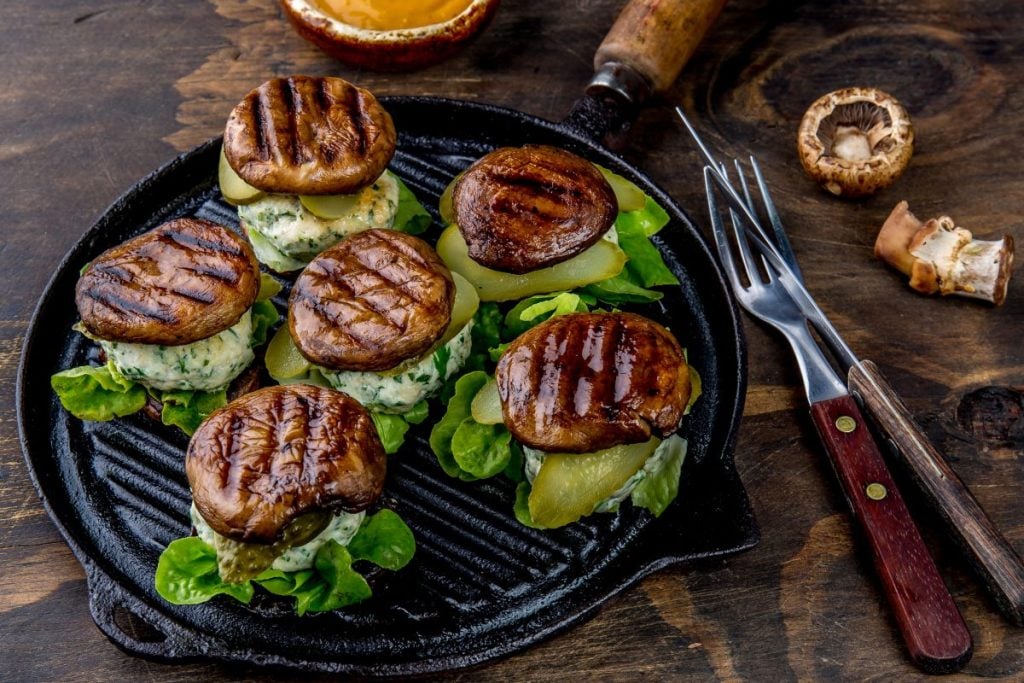
How to Make Mushrooms Taste Like Meat
A mushroom’s natural umami taste and meaty texture already get them most of the way. How you cook them dictates how similar to meat they taste.
It’s best to cook them the same way as you would a piece of meat or seafood. Coating them in batter or crumbs often helps to make them firmer and more meat-like.
Here are some recipe ideas to make mushrooms taste like meat:
- Roasted portobello and oyster mushroom shawarma
- Breaded fried chicken of the woods
- Mixed mushroom bolognese
- Portobello mushroom hot dogs
- Mushroom bacon bits
- Mushroom and black bean meatballs
- Lentil mushroom burgers
- Grilled portobello steaks
- Lion’s Mane Mushroom Crab Cake
Our article, “How To Cook Mushrooms: The Right Way!” has more tips on how to get the most out of your mushrooms.
And, for those of you who want more mushroom recipe ideas, we have put together “30 Of The Best Mushroom Recipe Ideas,” and for vegans, “25 Of The Best Vegan Mushroom Recipes.”

What is Mushroom Ketchup?
Today everyone associates ketchup with tomatoes, but this was not always the case.
In the early eighteenth century, the British recreated the flavors of a Chinese seasoning brought back by sailors and created a condiment made with mushrooms called ketchup.
It continued to spread and evolve, and in 1801 in America, people first added tomatoes to ketchup.
Ketchup is different from a sauce because it contains vinegar as one of the ingredients, whereas a sauce does not.
Making mushroom ketchup is a great way to preserve mushrooms before they go bad and make them last longer.
These days, many people make mushroom ketchup, not to preserve mushrooms, but because they enjoy the taste of this delicious condiment.
What Does Mushroom Ketchup Taste Like?
Mushroom ketchup is tangy, savory, and salty with a rich umami taste.
The mushroom flavor is usually subtle in this condiment, and people say it tastes like Worcestershire sauce.
Mushroom ketchup can also be slightly spicy depending on the recipe used to make it.
Different recipes use varied ingredients and seasoning to enhance the mushroom flavor, such as garlic, black pepper, bay leaves, thyme cloves, shallots and onions.
Final Thoughts
Incorporating different types of mushrooms into your daily meals adds unique flavors and provides numerous nutrients and health benefits.
Many delicious gourmet mushrooms are easy to grow at home. So if your local store or farmers market does not stock the mushrooms you want, try growing them at home.
Our Mushroom Growing Hub has more information on how to start and the different ways you can grow mushrooms at home.
And, if you’re a beginner eager to taste homegrown oyster mushrooms, our mushroom kit is the easiest way to get started.
